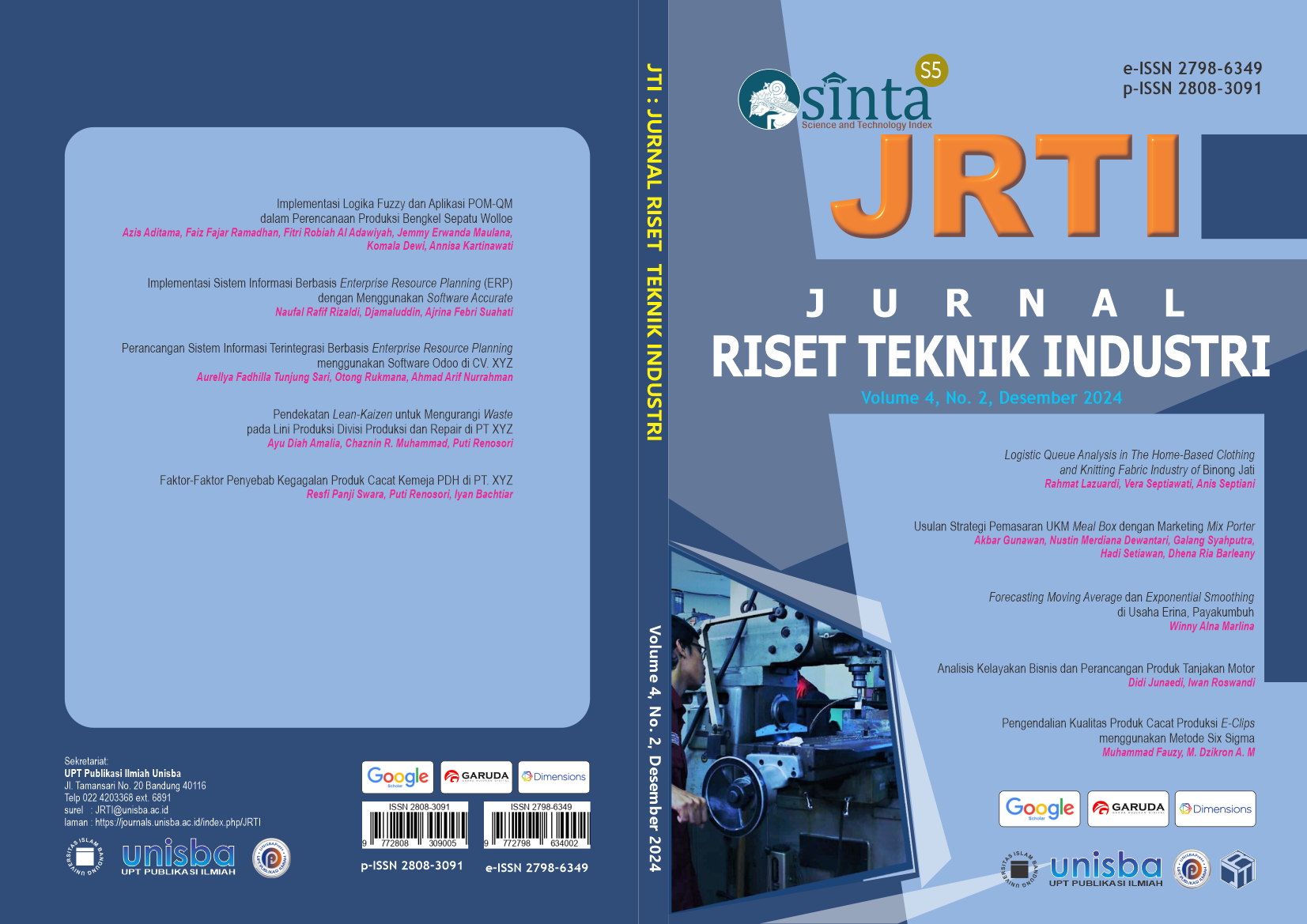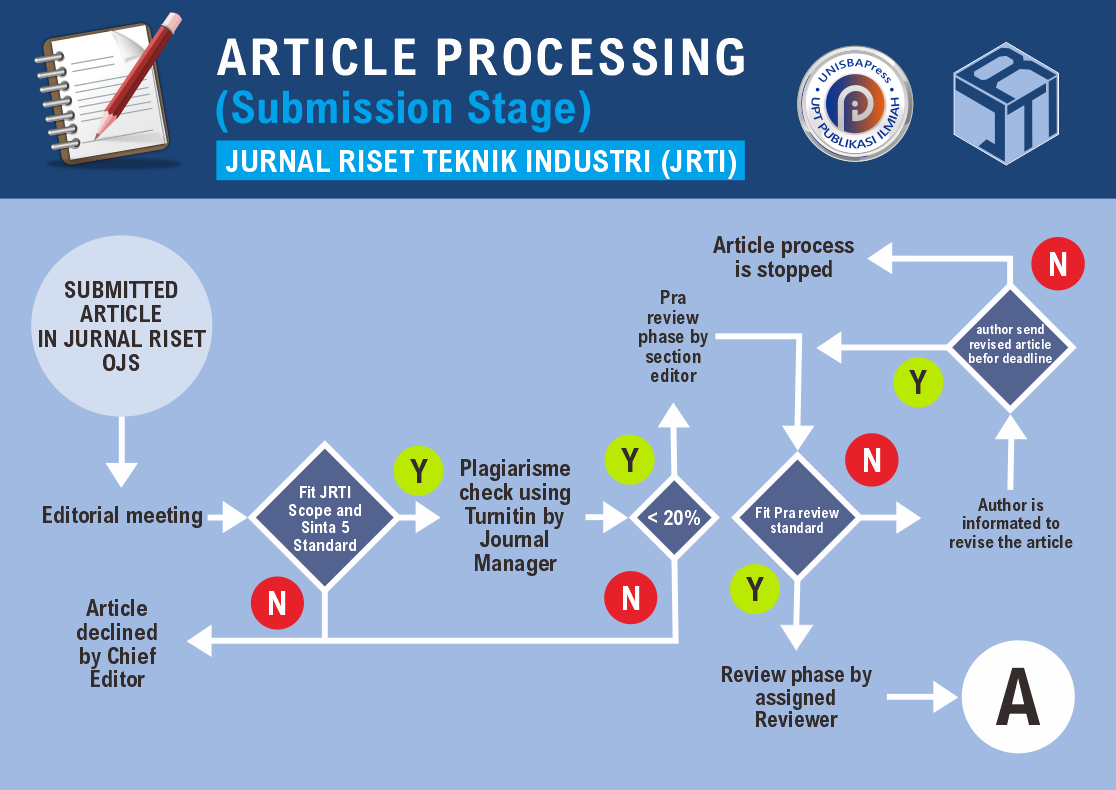Pengendalian Kualitas Produk Cacat Produksi E-Clips Menggunakan Metode Six Sigma
DOI:
https://doi.org/10.29313/jrti.v4i2.5439Keywords:
Six Sigma, DMAIC, QUALITY CONTROLAbstract
Abstrak. PT. XYZ adalah perusahaan manufaktur milik negara di Indonesia yang memproduksi produk militer dan non-militer. Penelitian ini menggunakan metode Six Sigma dengan tahapan DMAIC (Define, Measure, Analyze, Improve, Control) untuk mengidentifikasi masalah melalui Critical to Quality (CTQ) dan mengukur kinerja menggunakan DPU, DPO, DPMO, serta nilai sigma. Hasil analisis menunjukkan nilai DPMO sebesar 2091,46 dengan rata-rata sigma 5,24. Penyebab utama cacat diidentifikasi menggunakan diagram Pareto, p-chart, dan fishbone, yang mengungkap kontribusi signifikan dari aspek manusia, mesin, material, dan lingkungan. Usulan perbaikan meliputi pelatihan karyawan untuk meningkatkan pemahaman terhadap SOP, penjadwalan perawatan mesin secara preventif dan prediktif, penggantian atau kerja sama dengan vendor baru untuk bahan baku, serta perbaikan lingkungan kerja dengan pendingin sentrifugal dan alat pelindung telinga. Implementasi usulan ini diharapkan dapat mengurangi tingkat cacat, meningkatkan kualitas produk, dan meningkatkan efisiensi produksi E-Clips pada Divisi TC-AP PT. XYZ secara berkelanjutan.
Abstract. PT. XYZ is a state-owned manufacturing company in Indonesia that produces both military and non-military products. This study employs the Six Sigma methodology using the DMAIC stages (Define, Measure, Analyze, Improve, Control) to identify issues through Critical to Quality (CTQ) and assess performance using DPU, DPO, DPMO, and sigma levels. The analysis revealed a DPMO value of 2091.46 with an average sigma level of 5.24. The primary causes of defects were identified using Pareto diagrams, p-charts, and fishbone diagrams, highlighting significant contributions from human, machine, material, and environmental factors. The proposed improvements include employee training to enhance understanding of SOPs, scheduled preventive and predictive maintenance for machinery, replacement of or collaboration with new vendors for raw materials, and workplace enhancements with centrifugal cooling systems and ear protection equipment. The implementation of these recommendations is expected to reduce defect rates, improve product quality, and enhance the efficiency of E-Clips production in the TC-AP Division of PT. XYZ sustainably.
References
J. Suteja, “Mengenal Perusahaan Rintisan,” Universitas Pasundan, Bandung, 2020.
Jihan Idzni Hanifah, M. Dzikron, and Yanti Sri Rejeki, “Identifikasi Bahaya pada Aktivitas Perusahaan Peleburan Logam Alumunium Menggunakan Metode HIRARC,” Jurnal Riset Teknik Industri, pp. 89–98, Dec. 2023, doi: 10.29313/jrti.v3i2.2794.
V. Gaspersz and A. Fontana, Lean Six Sigma for Manufacturing and Services Industries. Bogor: Vinchristo Publication, 2011.
F. Elshadi and C. R. Muhammad, “Penerapan Metode Lean Six Sigma untuk Mereduksi Waste pada Produksi Sepatu Sandal,” Jurnal Riset Teknik Industri, pp. 17–26, Jul. 2022, doi: 10.29313/jrti.v2i1.664.
F. Elshadi and C. R. Muhammad, “Penerapan Metode Lean Six Sigma untuk Mereduksi Waste pada Produksi Sepatu Sandal,” Jurnal Riset Teknik Industri, pp. 17–26, Jul. 2022, doi: 10.29313/jrti.v2i1.664.
P. S. , N. R. P. , dan C. R. R. Pande, The Six Sigma Way: How GE, Motorola, and Other Top Companies Are Honing Their Performance. New York: McGraw Hill Professional, 2002.
A. Widodo and D. Soediantono, “Benefits of the Six Sigma Method (DMAIC) and Implementation Suggestion in the Defense Industry: A Literature Review,” International Journal of Social and Management Studies (Ijosmas), vol. 3, no. 3, pp. 1–12, 2022.
R. Sukwadi, L. Harijanto, M. M. W. Inderawati, and P. T. B. Huang, “Reduction in Rejection Rate of Soy Sauce Packaging via Six Sigma,” Jurnal Teknik Industri, vol. 22, no. 1, pp. 57–70, 2021, doi: 10.22219/jtiumm.vol22.no1.57-70.
A. Z. Al Faritsy and Angga Suluh Wahyunoto, “Analisis Pengendalian Kualitas Produk Meja Menggunakan Metode Six Sigma Pada PT XYZ,” Jurnal Rekayasa Industri (JRI), vol. 4, no. 2, pp. 52–62, 2022, doi: 10.37631/jri.v4i2.707.
D. Fortuna and E. Yuliawati, “Optimization of Manufacturing Company ’ s Production Process Using Lean Six Sigma,” vol. 16, no. 2, 2024.
Muhammad Yudio Saralino and Puti Renosori, “Usulan Perbaikan Kualitas Produk Menggunakan Metode SQCdan TRIZ,” Jurnal Riset Teknik Industri, pp. 49–58, Jul. 2024, doi: 10.29313/jrti.v4i1.3841.
R. Renaldi and D. S. Mulyati, “Usulan Perbaikan Kualitas Pelayanan Restoran Menggunakan Metode Servqual dan Kano,” Jurnal Riset Teknik Industri, pp. 109–116, Dec. 2022, doi: 10.29313/jrti.v2i2.1245.
Nadia Adzkia, D. S. Mulyati, and Selamat, “Usulan Perbaikan Kualitas Layanan di Bengkel Motor dengan Pendekatan Metode Servqual,” Jurnal Riset Teknik Industri, pp. 107–112, Dec. 2023, doi: 10.29313/jrti.v3i2.2850.
R. Saputri, P. Vitasari, and E. Adriantantri, “Identifikasi Timbulnya Produk Cacat Dengan Metode CTQ dan DPMO Pada Home Industry Keripik Tempe Sari Rasa,” Jurnal Valtech, vol. 5, no. 1, pp. 94–100, 2022.
G. F. Frederico, J. A. Garza-Reyes, A. Kumar, and V. Kumar, “Performance measurement for supply chains in the Industry 4.0 era: a balanced scorecard approach,” International Journal of Productivity and Performance Management, vol. 70, no. 4, pp. 789–807, May 2020, doi: 10.1108/IJPPM-08-2019-0400.
M. Amitava, Fundamental of quality control and improvement. New Jersey: Johm Wiley & Sons, Inc., Hoboken, Canada, 2016.
E. M. Goldratt and J. Cox, The Goal: A Process of Ongoing Improvement, 4th ed. New York: North River Press, 2004.
A. Anwar, “Application Quality Function Deployment to Improve the Quality of Services in Ngodoe Cafe,” International Journal of Innovation, Management and Technology, vol. 4, no. 6, 2013, doi: 10.7763/ijimt.2013.v4.464.
A. Reza Nugraha, M.Dzikron, and Iyan Bachtiar, “Usulan Perbaikan Kualitas Pelayanan Jasa Menggunakan Metode Service Quality (Servqual) dan Model Importance Performance Analysis (IPA),” Jurnal Riset Teknik Industri, pp. 9–16, Jul. 2023, doi: 10.29313/jrti.v3i1.1830.












